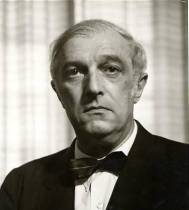
Clemens Heinrich Krauss (March 31, 1893 – May 16, 1954) was an Austrian conductor and opera impresario, particularly associated with the music of Richard Strauss. Krauss was born in Vienna, the out-of-wedlock child of Clementine Krauss, then a 15-year-old dancer in the Vienna Imperial Opera Ballet, later a leading actress and operetta singer, who was a niece of the prominent nineteenth-century operatic soprano, Gabrielle Krauss (1842-1904). His natural father, the chevalier Hector Baltazzi (1851-1916), belonged to a family of wealthy Phanariot bankers resident in Vienna. Baltazzi's older sister Helene was married to baron Albin Vetsera and was the mother of Marie Vetsera, who was thus Clemens Krauss' first cousin.
As a boy, Krauss was a chorister in the Hofkapelle (Imperial Choir). He attended the Vienna Conservatory, graduating in 1912. He studied composition with Hermann Graedener and theory with Richard Heuberger. After graduation he was chorus master in the Brno Theater (1912-1913). There he made his conducting debut in 1913. The famous Romanian soprano Viorica Ursuleac, with whom he often performed, was his second wife.
Krauss made the rounds of regional centers, conducting in Riga (1913-1914), Nürnberg (1915), and Szczecin (1916-1921), known then as Stettin. The latter appointment gave him ample opportunity to travel to Berlin to hear Arthur Nikisch conduct the Berlin Philharmonic, a major influence. Krauss's next post was back in Austria, where he became director of the opera and symphony concerts in Graz. In 1922 he joined the conducting staff of the Vienna State Opera and teacher of the conducting class at the State Academy of Germany. In 1923 he became conductor of the Vienna Tonkünstler Concerts until 1927, and Intendant of the opera in Frankfurt am Main and director of the Museum Concerts in 1924, until 1929.
Krauss visited the United States in 1929, conducting in Philadelphia and with the New York Philharmonic. Also in 1929 he became director of the Vienna State Opera. Its orchestra, in its independent concert form as the Vienna Philharmonic, appointed him its music director in 1930. He was a regular conductor at the Salzburg Festival from 1926 to 1934. In 1930 he conducted Alban Berg's Wozzeck.
In 1933 and 1934 Krauss gave up his Vienna positions, becoming director of the Berlin State Opera in 1935 after Erich Kleiber resigned in protest over Nazi rule. In 1933 he took over the preparations for the premieres of Strauss' Arabella when the conductor Fritz Busch (another non-Jewish anti-Nazi) left. Krauss' own position on Nazism was unclear although he enjoyed a close relationship with Nazi official Alfred Frauenfeld and it has been claimed that he sought Nazi Party membership in 1933. In 1937 he was appointed Intendant of the Nationaltheater München, following the resignation there of Hans Knappertsbusch. He became a close friend of Richard Strauss, for whom he wrote the libretto to the opera Capriccio which he premiered in Munich in 1942. Also, he conducted the premieres of Strauss's operas Friedenstag and Die Liebe der Danae.
After the Munich opera house was bombed, shutting it down, Krauss returned to conduct the Vienna Philharmonic until it closed shortly before the end of the War (1944-1945). After the War, Allied officials investigated his pro-Nazi activities and because of them forbade him from appearing in public until 1947. They also found that he had frequently acted to assist a number of individual Jews escape the Third Reich machine. When his ban was lifted he resumed frequently conducting the Vienna Philharmonic, including its famous New Year's Day concerts.
Following Krauss's rehabilitation he conducted at Covent Garden in London from 1951 and the Bayreuth Festival in 1953 . He died during a visit to Mexico City, and is now buried along with his wife, who died in 1985, in Ehrwald, Austria.
He did not make many recordings; but his 1950 performance of Johann Strauss II's Die Fledermaus, made in Vienna, is still regarded by some as the best one. His 1953 live performance of Richard Wagner's Ring Cycle from Bayreuth is highly regarded. A performance with the Vienna Symphony of Beethoven's Choral Fantasy, reissued on more than one inexpensive label since its original appearance on Vox Records, is also one of the few recordings featuring pianist Friedrich Wührer available on compact disc. Аи́да (итал. Aida) — опера Джузеппе Верди, либретто Антонио Гисланцони по сценарию О. Ф. Мариетта.
Действующие лица: Фараон — египетский царь (бас), Рамфис — верховный жрец (бас), Радамес — молодой начальник дворцовой стражи (тенор), Амнерис — дочь фараона (меццо-сопрано), Аида — эфиопская рабыня (сопрано), Амонасро — эфиопский царь, отец Аиды (баритон), гонец (тенор), жрецы, жрицы, придворные, солдаты, слуги, рабы и пленные эфиопы, египетский народ.
Действие происходит в Мемфисе и Фивах во времена владычества фараонов. В опере повествуется о несчастной любви предводителя египетских войск Радамеса и эфиопской рабыни Аиды — дочери эфиопского царя, с войсками которого сражаются египтяне.
A i d a Leonore Lafayette, Aida
Georgine von Milinkovic, Amneris
Josef Gostic, Radames
Ferdinand Frantz, Amonasro
Gottlob Frick, Ramfis
Walter Berry, Il Re
Chor und Orchester des Bayerischen Rundfunks
Conductor: Clemens Krauss
Broadcast Performance, Munchen, September 1953
| 
